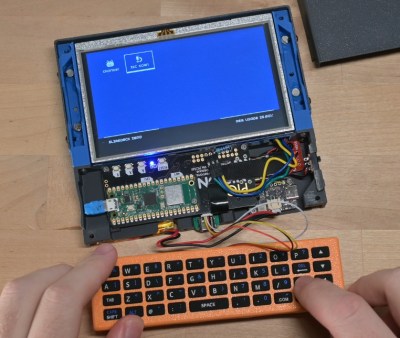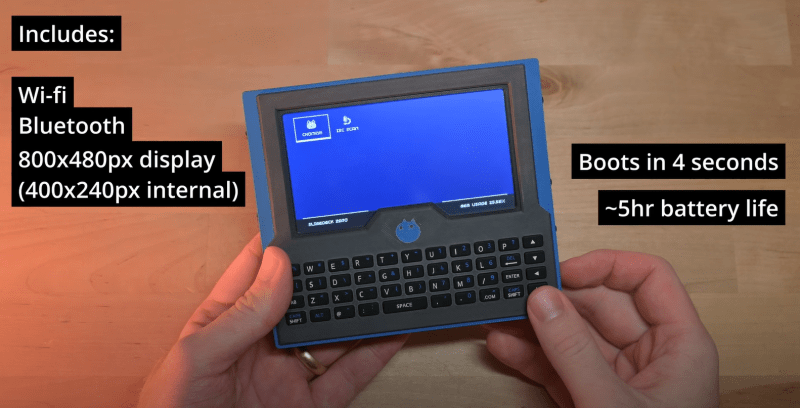[Abe] wanted the perfect portable computer. He has a DevTerm, but it didn’t quite fit his needs. This is Hackaday after all, so he loaded up his favorite CAD software and started designing. The obvious choice here would be a Raspberry Pi. But [Abe] didn’t want to drop in a Linux computer — he was going for something a bit smaller.
An RP2040 Pico would be a perfect fit. Driving a display with the Pico can be eat a lot of resources though. The solution was a PicoVision from Pimoroni. PicoVision uses two RP2040 chips. One drives an HDMI port, while the other is free to run application software. This meant a standard HDMI screen could be used.
 The keyboard was a bit harder. After a lot of searching, [Abe] found an IR remote designed for smart TVs. The QWERTY keyboard was the perfect size but didn’t have an interface he could use. He fixed that with an adapter PCB including an I2C GPIO expander chip. A bit of I2C driver software later, and he had a working input keyboard.
The keyboard was a bit harder. After a lot of searching, [Abe] found an IR remote designed for smart TVs. The QWERTY keyboard was the perfect size but didn’t have an interface he could use. He fixed that with an adapter PCB including an I2C GPIO expander chip. A bit of I2C driver software later, and he had a working input keyboard.
Hardware doesn’t do anything without software though. The software running on the handheld is called Slime OS, and the source is available at [Abe’s] GitHub. It’s a launcher, with support for applications written in python. [Abe] has a few basic demos working, but he’s looking for help to get more features up and running.
Although it wasn’t quite what [Abe] was after, our own [Donald Papp] came away fairly impressed when he gave the DevTerm a test drive back in 2022. Something to consider if you’re looking for a Linux handheld and not quite ready to build one yourself.
















Everything about this is great. The slimeos project confuses me a bit though. Pico’s don’t have a lot of resources how are they running python? Or is it micro python?
Either way I love the keyboard and layout
Looking at the github project, MicroPython is mentioned.
I liked the ancient PDAs that ran for days on a set of batteries. Other than that, I didn’t like them because there was jack s**t you could actually do with them. Typing in BASIC code for a simple text based blackjack game was entertaining for about an hour. The game itself, not very much.
If we had a sort of retro-future now where we’d be using these pocket calculator sized devices with a 16×4 LCD and 2-4 kB of RAM, possibly an add-on thermal printer and a cassette drive for a dock, what would you use them for? Other than the obvious text message/email terminal?
Me too, I’m wondering what his needs are. I would probably just connect a Bluetooth keyboard to my smartphone. It doesn’t need to boot and it has two day of battery life and I don’t have to write its OS and applications all by myself. But that wouldn’t be a hack. Kudos for the work, but I doubt its usefulness.
It’s the kind of usefulness that all bespoke things are: perfectly useful for one person. The beauty of this is the project itself. Admirable display of skills, nice challenge to keep the brain all limbered up, and a satisfying example that one can pull a project together from planning, through iteration, to completion. Inspirational for a show off piece
A devterm device has the point of writing the software yourself as an exercise, and playing little games or writing emails on the go. It’s basically a device for hacking, for the point of hacking.
The question was rather, what was the point of the original form factor and devices when they entered the market in the 80’s and what would you use them for now?
I’m talking about things like
https://en.wikipedia.org/wiki/Sharp_PC-1211
I remember playing around with that. It had one program in memory from the previous user, that queried the user for a cable type, wire size and length, and calculated some engineering parameters that it could print out on the matrix printer. The company that used it already had that information in a little booklet so it was basically just a slower way of checking a standard table of values. I suppose that’s the reason they only ever bought one.
I think they thought it would be an elaborated programmable calculator, loaded with a bunch of user-defined routines specific to their needs. By the time I got to play with it, everyone had proper computers that ran BASIC and other stuff, so it was outmoded as an office/lab helper. The only advantage over booting up your desktop PC was that it was instant on, and fit in your pocket, so theoretically you could swipe it out anywhere and calculate the properties of the cable you wanted… but why, and where? Designing new transmission lines while sitting on the can?
Also, interesting parallels:
” PicoVision uses two RP2040 chips. One drives an HDMI port, while the other is free to run application software. ”
“The Sharp PC-1211 (…) was powered by two 4-bit CPUs laid out in power-saving CMOS circuitry. One acted as the main CPU, the other dealt with the input/output and display interface.”
yeah! one of those sharps, with the little printer dock, landed in my lap in the late 90s. i was, on the one hand, blown away by how incredibly neato it is. and on the other hand, absolutely at a loss for what to do with it
Wikipedia: “BYTE stated that “neither Tandy nor any of the other pocket-computer makers really know if there is a meaningful market for this machine”. The magazine said that the vendors expected that businessmen would use them with a modem to communicate with larger computers.”
So they were meant to be some sort of minimalist programmable terminals?
I expect the main use envisaged for them was people who wanted better programmable calculators, especially with the ability to save programs to tape.
I seem to recall that small computers of this type (maybe later iterations) had docks with printers, and tape decks.
I think people were just throwing ideas at the wall and seeing what stuck though, it wasn’t much later that the TRS80 model 100 came along which was less portable but far more capable.
The very first one (Sharp) had a printer and a tape deck as an accessory.
My smartphone generally stays on standby – otherwise I couldn’t receive any phone calls.
hey. what a coincidence. they mentioned a prohect like that on https://thingswithjustabluetoothkeyboardandaphoneaday.com
you should check that out right away!
I started typing a comment with my thoughts on this but it was so long I decided to make it as a page on my HaD.io profile, which can be read here: https://hackaday.io/page/399320-portable-personal-hardware
But tl;dr… Why and what for this device? Probably a natural reaction to the iron grip google and apple have on portable personal devices, so hackers and makers feel compelled to create some sort of device that is open source, without any creepys built into hardware or software.
We are years away from these devices having the functions current smartphones do, but I think all these MCU based dev consoles and raspberry pi cyberdecks are a step in the right direction. Even if the device has little to no real world purpose, it gets people thinking about creating their own hardware devices and software to run on them.
“I started typing a comment with my thoughts…”
Wow! You must have NeuraLink or something, I was thinking, when I first read this.
I already wrote it on HaD: the amount of hand held projects, proves that there is a market for them. We are just looking for the right form-hardware-software combo. And smartphones are amazing but limited in their own way.
Guys, you’re missing the point. It’s not everybody’s “perfect”, it’s [Abe’s] “perfect”.
Personally, I’m curious what all you could make a small RGB screen attached to an ESP32 with a small number of buttons, a battery, and a case, could all be capable of doing. I’ve got a Casio Data Bank watch with six buttons, five alarms, a second clock, and both count up and down timers, and that’s very useful for me.
Would there be space to squeeze a temperature sensor in there? How about a Micro USB port? A MicroSD card slot? Could it run off two CR2032 cells instead of a rechargeable one? No idea until I start doing the research.
yeah and everyone’s wondering what Abe does with his computer that makes this perfect. i’m not going to watch the youtube video to find out either :)
Having watched this before I found this article, he doesn’t really know either.
The most fun I’ve ever had with a PDA myself is playing Sudoku on it, but that’s not really any kind of useful work.
In my case, having a clock and multiple timers would be rather useful, as well as a temperature and humidity sensor, would be some baseline of usefulness, but what’s possible beyond that? Especially if it doesn’t need internet access?
Agree. All the screens in the ILI9341 or ST7789 range that go well with the ESP32 or Pico sort of level are at most 4.0″, which is just a BIT small for doing anything useful. 5″ is OK, but all i can find is HDMI in that size, so you end up doing what this project did.
I need fuzix
I still miss my Psion 3c. Spreadsheet, database. word processor, diary, etc. It was stolen from my jacket pocket, so it must have been useful to someone else! 😃
Back in the early 90s I had a job where I could buy such “toys” to evaluate their usefulness for specific tasks at work (e.g., scanning property barcodes, updating their location; used for onsite package delivery with tracking; allowing network engineers to log into VAXs & other computers to change/update config, etc).
There were a few that I liked.
The most useful one was a mil-spec one shaped like DMM, but thicker & heavier due to the battery and a built-in heater for use in cold conditions.
Inside, was a simple Linux computer, the screen size was about like my current phone, but if course lower res.
But the actually keypad was lacking, it was for very simple data entry.
And, though it was water & mud proof, we really had no use for the “heater.”. ( I think it was mostly for the primitive LCD screen, lol.)
I also personally had a little Casio PDA that had word processor & spreadsheet type apps, also calendar & others. It was big enough to be useful, and the case with the keyboard folded shut clamshell style, and it fit easily in the breast pocket of my sport coat.
I loved that thing, I could use it to take notes, write reports, schedule things, and more. The case was great, it made the things almost indestructible!
Unfortunately, it stopped working one day. I never found anything to replace it, either!
So, I’m always on the lookout for something like that, even though now, I don’t have those same uses for it.
Besides, I can write faster using a Swiftkey type app (sliding my finger around) on my smartphone nowadays, and I only need to carry one device.
I still like such projects, whether I have a use for them or not.
They’re good show-off pieces, if nothing else, and hopefully they have a use for the developer who made it!
My objection to these is they usually upload everything you write to dubious online entities.